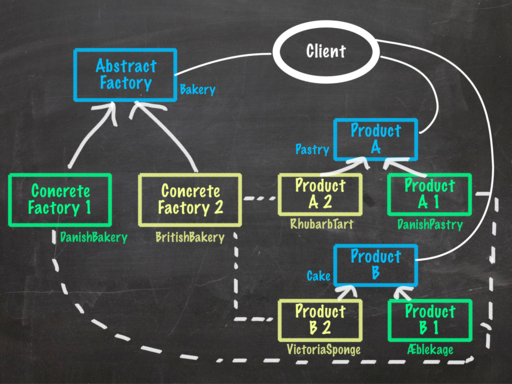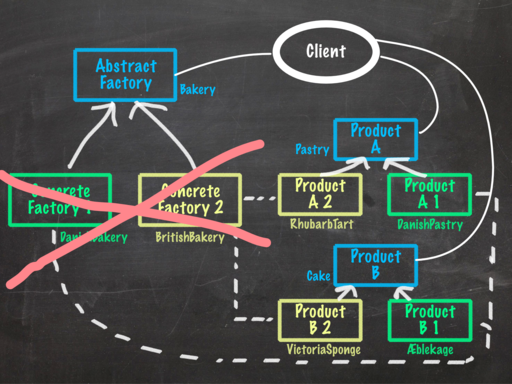Design Patterns in the 21st Century: The Abstract Factory Pattern
by Samir Talwar
Tuesday, 14 April 2015 at 09:51 BST
This is part two of my talk, Design Patterns in the 21st Century.
This pattern is used everywhere in Java code, especially in more “enterprisey” code bases. It involves an interface and an implementation. The interface looks something like this:
public interface Bakery {
Pastry bakePastry(Topping topping);
Cake bakeCake();
}
And the implementation:
public class DanishBakery implements Bakery {
@Override public Pastry bakePastry(Topping topping) {
return new DanishPastry(topping);
}
@Override public Cake bakeCake() {
return new Aeblekage(); // mmmm, apple cake...
}
}
More generally, the Abstract Factory pattern is usually implemented according to this structure.

In this example, Pastry and Cake are “abstract products”, and Bakery is an “abstract factory”. Their implementations are the concrete variants.
Now, that’s a fairly general example.
In actual fact, most factories only have one “create” method.
@FunctionalInterface
public interface Bakery {
Pastry bakePastry(Topping topping);
}
Oh look, it’s a function.
This denegerate case is pretty common in in the Abstract Factory pattern, as well as many others. While most of them provide for lots of discrete pieces of functionality, and so have lots of methods, we often tend to break them up into single-method types, either for flexibility or because we just don’t need more than one thing at a time.
So how would we implement this pastry maker?
public class DanishBakery implements Bakery {
@Override public Pastry apply(Topping topping) {
return new DanishPastry(Topping topping);
}
}
OK, sure, that was easy. It looks the same as the earlier DanishBakery except it can’t make cake. Delicious apple cake… what’s the point of that?
Well, if you remember, Bakery has a Single Abstract Method. This means it’s a Functional Interface.
So what’s the functional equivalent to this?
Bakery danishBakery = topping -> new DanishPastry(topping);
Or even:
Bakery danishBakery = DanishPastry::new;
Voila. Our DanishBakery class has gone.
But we can go further.
package java.util.function;
/**
* Represents a function that
* accepts one argument and produces a result.
*
* @since 1.8
*/
@FunctionalInterface
public interface Function<T, R> {
/**
* Applies this function to the given argument.
*/
R apply(T t);
...
}
We can replace the Bakery with Function<Topping, Pastry>; they have the same types.
Function<Topping, Pastry> danishBakery = DanishPastry::new;
In this case, we might want to keep it, as it has a name relevant to our business, but often, Factory-like objects serve no real domain purpose except to help us decouple our code. (UserServiceFactory, anyone?) This is brilliant, but on these occasions, we don’t need explicit classes for it—Java 8 has a bunch of interfaces built in, such as Function, Supplier and many more in the java.util.function package, that suit our needs fairly well.
Here’s our updated UML diagram:

Aaaaaah. Much better.
Tomorrow, we’ll be looking at the Adapter pattern.
If you enjoyed this post, you can subscribe to this blog using Atom.
Maybe you have something to say. You can email me or toot at me. I love feedback. I also love gigantic compliments, so please send those too.
Please feel free to share this on any and all good social networks.
This article is licensed under the Creative Commons Attribution 4.0 International Public License (CC-BY-4.0).